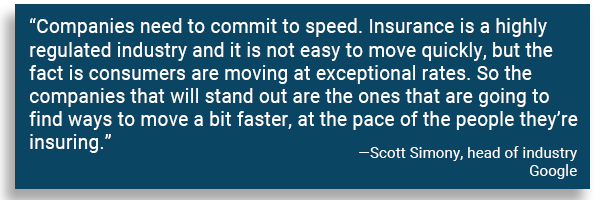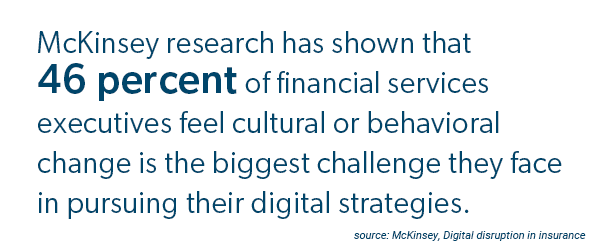Commercial lines insurers are moving forward on their digital journeys, spurred by customer demands and the acceleration of digital capabilities in the world at large. In earlier phases of the industry’s digital journey, all the attention was on personal lines. Commercial lines, especially those covering the more complex risks, were left behind in the wave of digital, mobile and insurtech activity that was sweeping other parts of the industry. That is no longer true.
The tremendous potential of digitizing assets and digitizing the customer experience is now well-recognized, and transformation is well underway.
However, there have been some significant shifts in digital project priorities over the past year due to the pandemic. The move to the lockdown/work-from-home environment that occurred practically overnight exposed key gaps in insurers’ capabilities. Throughout 2020, commercial lines companies prioritized projects to support agents, policyholders and employees seeking digital, remote capabilities. These new priorities have carried over into 2021, although the projects for insurers are at different stages of maturity for those focused on small commercial and mid-market/large commercial.
A new SMA research report, Digital Transformation in Commercial Lines: Project Priorities for 2021, identifies specific plans for small and mid/large commercial lines insurers related to a variety of digital projects. There are some commonalities across lines. For example, the foundation for digital transformation is deemed to be modern core systems and continuing to digitize assets. Although these projects may not, by themselves, drive transformation, they are vital enablers for a whole range of more transformative digital projects. More information must be in digital formats, and the systems of record that manage key transaction flows and data must be built on modern architectures that provide the flexibility and adaptability needed in the digital age. Some key focus areas for small and mid/large commercial are as follows:
Small Commercial:
Increasing the percentage of business that can be handled via straight-through processing (STP) is a top priority. In conjunction with that goal, upgrading to next-generation portals is high on the project list for many insurers. STP starts with being able to capture more data in structured data formats, which is where portals can aid. Next-gen portals are also designed to meet the expectations of agents and policyholders for digital interactions. Insurers focused on small commercial are generally further along regarding digital platforms and implementing transformational technologies.
Mid/Large Commercial:
Insurers serving these segments focus on foundational elements such as implementing modern policy, billing and claims systems. There is also significant project activity for policyholder self-service capabilities, chiefly because other lines in P&C have already implemented those capabilities, and mid/large is catching up. One interesting area of focus is in using AI technologies such as natural language processing and machine learning for unstructured data. In this area, the insurers focused on mid/large business are forging ahead of the rest of the industry. The complexity of the business and the vast volume and variety of forms, letters, documents and other unstructured data result in major opportunities for automation and insight.
The plans for 2021 signal another year of advancement in the digital journeys of commercial lines insurers, in spite of the pandemic. As the decade progresses, insurers will be moving beyond the earlier phases of digitizing assets and enabling digital interactions as they position themselves for true digital transformation – resulting in more innovative products, new partnerships and new business models. Those that successfully transform will distance their companies from the competition.

















































